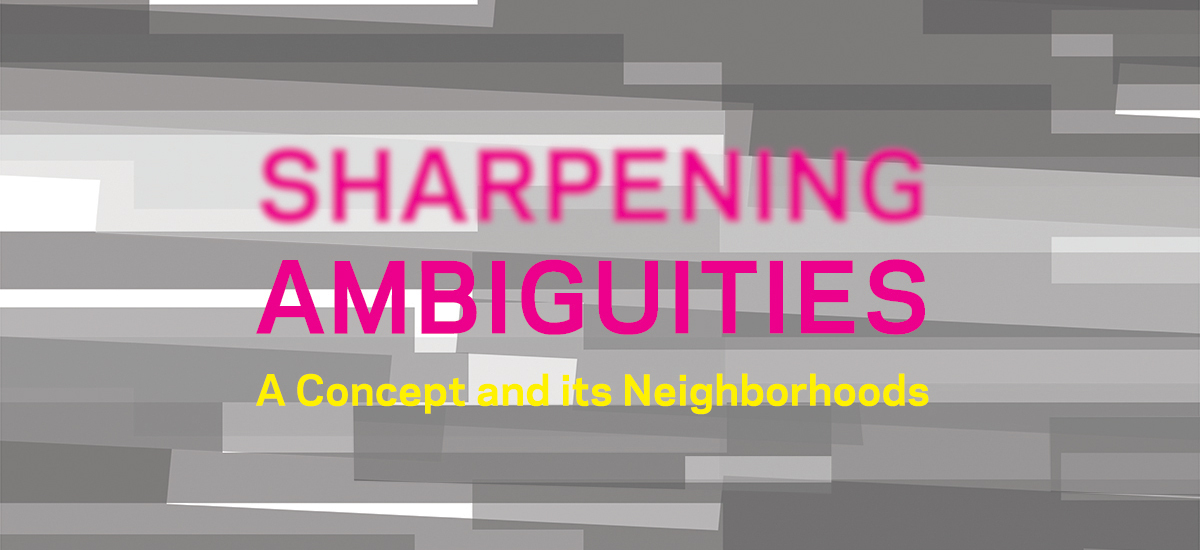Welcome
Sharpening Ambiguities.
A Concept and its Neighborhoods
Conference at the University of Duisburg-Essen, September 22 to 24, 2021
Within cultural studies (especially within the German-speaking discourse), 'ambiguity' has been established as a productive research concept. It is used for the description of both contemporary experiences and premodern social orders. The concept combines rhetorical-linguistic as well as sociological-historical theory traditions without, however, fully clarifying the relationship between 'ambiguity' and the conceptual tools of these traditions. The conference “Sharpening Ambiguities. A Concept and its Neighborhoods" aims at contributing to such a clarification by comparing and contrasting ‘ambiguity’ to various neighboring terms. The starting point of this discussion is the hypothesis of the Research Unit “Ambiguity and Distinction. Historical and cultural Dynamics” that the concept of ambiguity best unfolds its analytical potential when it is combined with the concept of distinction. ‘Distinction’ is not understood as an antonym to identity, but rather, as it is understood in social systems theory, as the condition of its possibility: in order to be able to form some kind of identity, any given occurrence must first be distinguished from something (or from everything) else. Every such distinction is dependent on the perspective of an observer. What one observer describes as ambiguous may well be judged as unambiguous by another. People, groups, institutions, but also works of art or literary genres can count as observers. By imposing a certain distinction, these observers assume its adequacy, i.e. they assume that the distinction will enable the reduction of complexity in a given situation. Within this theoretical framework, ambiguity can be described as the experience that a given assumption of adequacy is wrong because the distinction preferred by the observer turns out to be not or not entirely applicable to certain phenomena.
This creates situations of epistemic openness in which the usual distinctions do not apply and instead new solutions – be they semantic or pragmatic – have to be found. Situations of ambiguity therefore have the potential for creative solutions, which can then either prevail and trigger processes of cultural change, or may be 'forgotten' and remain without consequences.
The concept of ambiguity as it is proposed by the research group “Ambiguity and distinction. Historical-cultural dynamics” is closely related to various other concepts, some of which have long been established in cultural studies. The conference attempts to sharpen ‘ambiguity’ by placing it in relation to these concepts. It will take place from September 22-24, 2021 at the University of Duisburg-Essen. So far, the following colleagues have confirmed their participation: Hanna Engelmeier (Essen), Stefan Hirschauer (Mainz), Ulrike Kistner (Pretoria), Gesa Lindemann (Oldenburg), Tobias Schlechtriemen (Freiburg), Barbara Stollberg-Rilinger (Wissenschaftskolleg Berlin), and Rudolf Stichweh (Bonn).
The focus of the discussion will be on the conceptual relations between ambiguity and 1) indifference, 2) polyvalence and plurality, 3) mimicry/mimesis as well as 4) the figures of the third (Figuren des Dritten).
- If it is true that ambiguity results from the impossibility of applying preferred distinctions, then ambiguity shares the aspect of non-differentiation with the concept of indifference. Can we understand ambiguity as an impossibility and indifference as an omission of a distinction? Is indifference one among several ways of reacting to experiences of ambiguity? Or is it ambiguity itself which makes indifference impossible?
- Polyvalences can be understood as a change in the scheme of distinction or a change of the observer, while ambiguity is characterized by the fact that such changes are not possible or at least very difficult. Is this a sustainable/plausible differentiation? Do not all forms of ambiguity ultimately lead to polyvalences? Is ambiguity, as it is often used to describe works of art, a way of undermining distinctions and unsettling our common ways of distinguishing? Do various forms of communication differ in this respect, for instance artistic and scientific communication?
- The terms mimesis and mimicry open the concept of ambiguity to the question of the relationship between likeness and original, deception and authenticity. In which areas of communication do such ambiguities appear? How is the distinction between the real and the depicted stabilized? What is blurring it? What can be gained by contrasting mimesis and mimcry to ambiguity?
- The observation of ambiguity can be stabilized through further communicative use so that ambiguity itself can become an phenomenon which can be expected. Are “figures of the third” (Figuren des Dritten) to be understood as forms in which such a stabilization takes place? What are the conditions for figures of the third to emerge when in the face of observations of ambiguity? What functions do they fulfill for the observation of ambiguity?
The conference will address these and further questions in four panels and a concluding discussion. Each of these panels will be dedicated to a neighboring concept and will be comprised of an introduction to the topic, two 30-min lectures and a commentary.
With this event we hope to increase the clarity of ambiguity as a concept and, by doing so, strengthen its analytical value. Moreover, we would like to bring various cultural and social science disciplines into conversation with one another by initiating the discussion of several neighboring concepts. The presentations within the individual panels should relate to ambiguity and the respective neighboring concepts discussed, but are free in their choice of topics and "altitude". Therefore, both observations on individual phenomena and basic theoretical considerations are welcome contributions.
Due to the Corona pandemic response measures, only a limited number of participants will allowed. Therefore, we ask to please register by September 15 with an e-mail to for2600@uni-due.de.
Please note that to attend the conference you must be certified fully vaccinated, recovered or tested. The conference hosts are obliged to check these certificates.
Contact:
Web www.uni-due.de/forschungsgruppe_2600
Mail for2600@uni-due.de

